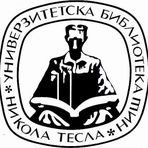Title
Prilog poboljšanju linearnosti mikrotalasnih pojačavača snage
Creator
Atanasković, Aleksandar S. 1974-
Copyright date
2014
Object Links
Select license
Autorstvo 3.0 Srbija (CC BY 3.0)
License description
Dozvoljavate umnožavanje, distribuciju i javno saopštavanje dela, i prerade, ako se navede ime autora na način odredjen od strane autora ili davaoca licence, čak i u komercijalne svrhe. Ovo je najslobodnija od svih licenci. Osnovni opis Licence: http://creativecommons.org/licenses/by/3.0/rs/deed.sr_LATN Sadržaj ugovora u celini: http://creativecommons.org/licenses/by/3.0/rs/legalcode.sr-Latn
Language
Serbian
Cobiss-ID
Theses Type
Doktorska disertacija
description
Datum odbrane: 27.06.2015.
Other responsibilities
mentor
Milovanović, Bratislav D.
član komisije
Maleš-Ilić, Nataša 1968-
član komisije
Marković, Vera 1956-
član komisije
Jokanović, Branka
član komisije
Pronić-Rančić, Olivera 1969-
Academic Expertise
Tehničko-tehnološke nauke
University
Univerzitet u Nišu
Faculty
Elektronski fakultet
Group
Katedra za telekomunikacije
Alternative title
Contribution to linearity improvement of microwave power amplifiers
Publisher
[A. S. Atanasković]
Format
XVI, 219 listova
description
Biografija autora: list [220]
description
Telecommunications
Abstract (en)
In new generation of wireless communication systems (WCDMA, CDMA-2000, 3G, 3.5G, LTE, 4G, …), where spectrum efficient linear modulation formats are used, the linearity of power amplifier (PA) is a very essential requirement. On the other hand the PA highly consumes power referring to other components in a wireless communication system. Therefore, power amplifier should satisfy high power added efficiency (PAE) and good linearity simultaneously. However, in a design a compromise between PAE and linearity has to be accepted. PAs are usually operated with a back-off in order to fulfill linearity specifications, which in turn results in a lower power efficiency. If PAs operate near to saturation region where they show highly nonlinear characteristics great efficiency is achieved, and amplifier linearization may be performed by using some external circuitry. Different PA linearization methods such as feedback, feedforward, predistortion, etc. have been developed and are commercially available.
This thesis considers the linearization of microwave power amplifier by applying the method that uses the second harmonics of the fundamental signals (IM2) and the fourth-order nonlinear signals (IM4) at frequencies that are close to the IM2 signals in order to lower the third and fifth order intermodulation products. After been adjusted in amplitude and phase, IM2 and IM4 signals are delivered to the input and output of the microwave power amplifiers. The linearization signals are mixed with the fundamental signals generating the additional intermodulation products of the third and fifth order that are adjusted in amplitude and phase to reduce the original intermodulation products existing
due to the nonlinear amplifier characteristic. This technique can be applied for a wide range of fundamental signals’ power going close to 1-dB compression point and on different configurations of microwave power amplifiers - a single stage amplifiers, multi-stage cascade amplifiers, different configuration of two-way, three-way and three-stage Doherty amplifiers, etc.
The main achievements of this thesis are:
• theoretical development of the linearization method that uses IM2 and IM4 signals in order to improve the IM3 and IM5 products which can be successfully applied in a wide range of fundamental signals’ power going close to 1-dB compression point;
• use of the linearization signal at the second harmonic frequency of fundamental signals in order to minimize the influence of the linearization signals on fundamental signals
• implementation and verification of the proposed linearization method on a number of different types of microwave power amplifiers, primarily on various types of Doherty amplifiers;
• modification of Doherty amplifying structure in order to ensure the ability to exploit peaking amplifiers as generators of signals for linearization;
• experimental verification of the proposed linearization method, which is, based on the author's best knowledge, for the first time applied on fabricated two-way Doherty amplifier for different types of digitally modulated signals.
Authors Key words
linearizacija, pojačavači snage, Doherty pojačavači, drugi harmonici, nelinearnosti četvrtog reda, intermodulacioni produkti, efikasnost, mikrotalasi
Authors Key words
linearization, power amplifiers, Doherty amplifiers, second harmonics, fourth-order nonlinear signals, intermodulation, efficiency, microwave
Classification
621.3.029.6+621.375:621.317
Subject
621.39
Type
Elektronska teza
Abstract (en)
In new generation of wireless communication systems (WCDMA, CDMA-2000, 3G, 3.5G, LTE, 4G, …), where spectrum efficient linear modulation formats are used, the linearity of power amplifier (PA) is a very essential requirement. On the other hand the PA highly consumes power referring to other components in a wireless communication system. Therefore, power amplifier should satisfy high power added efficiency (PAE) and good linearity simultaneously. However, in a design a compromise between PAE and linearity has to be accepted. PAs are usually operated with a back-off in order to fulfill linearity specifications, which in turn results in a lower power efficiency. If PAs operate near to saturation region where they show highly nonlinear characteristics great efficiency is achieved, and amplifier linearization may be performed by using some external circuitry. Different PA linearization methods such as feedback, feedforward, predistortion, etc. have been developed and are commercially available.
This thesis considers the linearization of microwave power amplifier by applying the method that uses the second harmonics of the fundamental signals (IM2) and the fourth-order nonlinear signals (IM4) at frequencies that are close to the IM2 signals in order to lower the third and fifth order intermodulation products. After been adjusted in amplitude and phase, IM2 and IM4 signals are delivered to the input and output of the microwave power amplifiers. The linearization signals are mixed with the fundamental signals generating the additional intermodulation products of the third and fifth order that are adjusted in amplitude and phase to reduce the original intermodulation products existing
due to the nonlinear amplifier characteristic. This technique can be applied for a wide range of fundamental signals’ power going close to 1-dB compression point and on different configurations of microwave power amplifiers - a single stage amplifiers, multi-stage cascade amplifiers, different configuration of two-way, three-way and three-stage Doherty amplifiers, etc.
The main achievements of this thesis are:
• theoretical development of the linearization method that uses IM2 and IM4 signals in order to improve the IM3 and IM5 products which can be successfully applied in a wide range of fundamental signals’ power going close to 1-dB compression point;
• use of the linearization signal at the second harmonic frequency of fundamental signals in order to minimize the influence of the linearization signals on fundamental signals
• implementation and verification of the proposed linearization method on a number of different types of microwave power amplifiers, primarily on various types of Doherty amplifiers;
• modification of Doherty amplifying structure in order to ensure the ability to exploit peaking amplifiers as generators of signals for linearization;
• experimental verification of the proposed linearization method, which is, based on the author's best knowledge, for the first time applied on fabricated two-way Doherty amplifier for different types of digitally modulated signals.
“Data exchange” service offers individual users metadata transfer in several different formats. Citation formats are offered for transfers in texts as for the transfer into internet pages. Citation formats include permanent links that guarantee access to cited sources. For use are commonly structured metadata schemes : Dublin Core xml and ETUB-MS xml, local adaptation of international ETD-MS scheme intended for use in academic documents.


